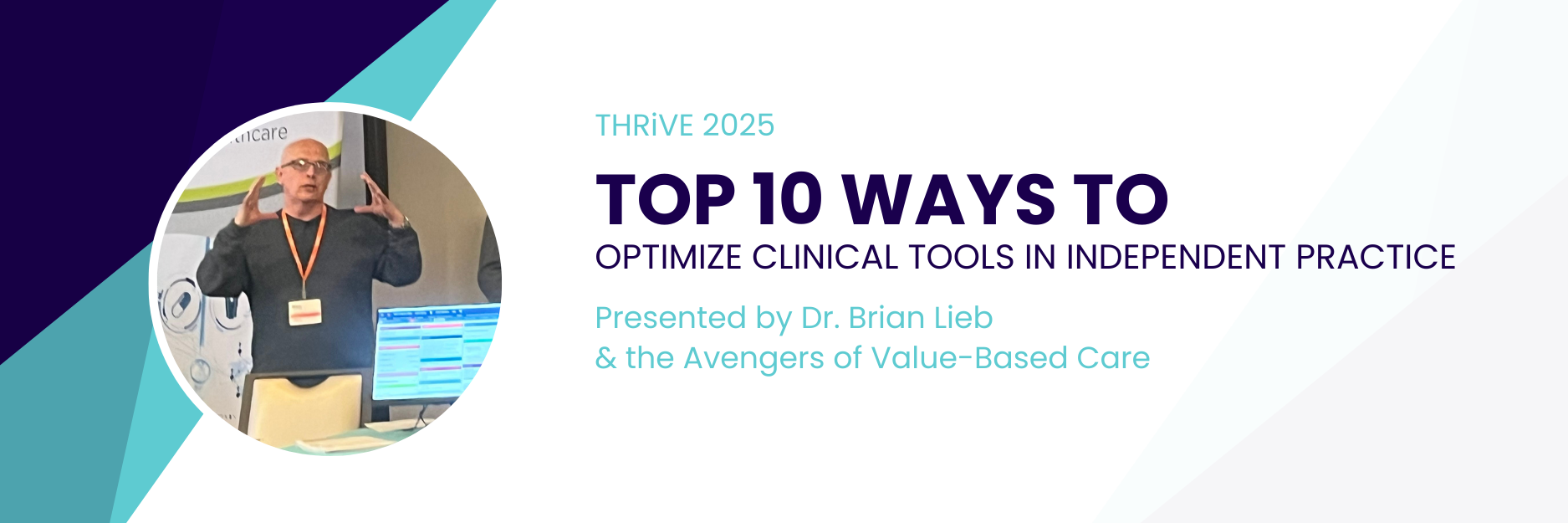
On Saturday, May 17th, Brian Lieb, DO, moderated a panel titled “Excellence in Care – Optimizing Our Clinical Tools” at the THRiVE Healthcare Summit in Pittsburgh, Pennsylvania. This panel brought together innovative leaders in independent medicine to discuss optimizing referrals, EMR systems, AI tools, chronic care programs and team-based workflows. Panelists included Sudhir Rao, MD, Raul Vazquez, MD, Alecia Hutsler, DO, and James L. Gardner III, MD, each offering practical strategies grounded in real-world results.
Dr. Lieb opened with a critique of modern corporate medicine, highlighting high turnover, lack of continuity and impersonal care. His return to private practice during COVID allowed him to engage in value-based care through ACO and CIN participation, implement RPM/CCM services and quality initiatives and build a high-functioning, mission-driven clinical team.
Key Insight: Investment and commitment—not contracts—create stable, patient-first care.
Dr. Rao stressed the need for EMRs to streamline referrals and automate communication back to referring physicians and noted that even “automated” systems often fail due to IT glitches, requiring staff workarounds. He advocated for a hybrid documentation model: concise, narrative clinical notes that still meet coding needs.
Dr. Vazquez described how EMR-driven referrals and documentation helped his practices achieve high-risk scores and avoid liability. He leveraged MEDENT’s Community Chart and Care Coordination tools to optimize workflow. He also emphasized the need to close referral loops as 20% of referrals go uncompleted, causing huge cost implications under value-based models.
Key Tools: Collaborative Editor, Cross-practice scheduling, EMR-integrated triage tracking, MEDENT’s formulas for population health calls.
The panelists discussed that coding accuracy is essential for maximizing PMPM payments. Dr. Lieb and Dr. Gardner use backend teams to help optimize documentation.
Key Insight: Precision coding = improved risk scores = sustainable revenue for high-quality care.
Dr. Vazquez shared how he scaled practices by:
Using EMRs not just for documentation, but as operational platforms for billing, training and audit prep.
Cross-training staff and leveraging automation tools like kiosks and pre-visit checklists.
Designing 152 care plan templates for clinical standardization across PAs and NPs.
Driving $1-1.5M revenue per year per primary care site, enabling reinvestment into care coordination.
“We don’t run practices like businesses, but we should,” he said. “That’s how we save medicine.”
Dr. Hutsler admitted early learning curves, but saw clear benefits, including better patient outcomes and stronger relationships, prevention of costly hospitalizations and improved documentation for chronic conditions. She utilized FocusMD to manage RPM with efficient team-based workflows and embraced servant leadership, stepping in to answer phones, take vitals and lead huddles.
Key Insight: RPM/CCM success requires team buy-in, educating patients and lean systems.
Dr. Gardner uses Suki AI within MEDENT for ambient documentation, enabling voice-to-note capture with minimal to no typing. He combines it with plan packages, BOI tools and pre-visit nurse prep to complete notes before leaving the room. He also emphasized the value of super users and ongoing training to prevent regression to outdated habits.
Meanwhile, Dr. Lieb and others echoed that optimization sessions with EMR consultants are essential to reduce click fatigue. He also stressed the focus on one-screen dashboards for high-risk diseases to capture value and quality measures efficiently.
Dr. Hutsler and audience members discussed giving medication samples to help patients in the Medicare donut hole. These don’t show up in claims data, potentially hurting compliance scores. The solution is to log samples with lot #s and expiration in the EMR and challenge payer denials using documentation and audit trails (timestamped logs, source docs).
“It’s not what you know, it’s what’s documented,” Dr. Vazquez said.
ACO Building & Accreditation
Dr. Vazquez shared how he built New York’s first NCQA-accredited ACO with MEDENT’s support. He used two weeks of downtime to create the systems needed for accreditation. PM/PM payments and NCQA recognition led to sustainable team-based care and over $12M in shared savings returned to doctors.
After selling to PE, Dr. Vazquez saw the system he built dismantled in just two to three years. He urged fellow clinicians to retain ownership or control of their platforms and contracts. PE will prioritize ROI, not patients or team members.
Risk scores drive revenue.
EMRs must do more than charting. Optimized them for communication, coding and scheduling.
Train super users and optimize regularly.
Build systems that scale across teams.
Put patients first, and let business follow.